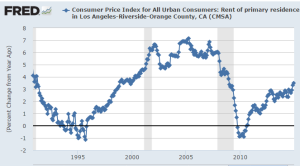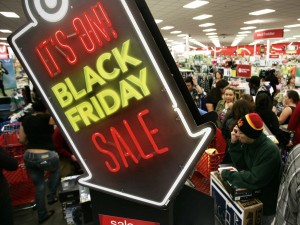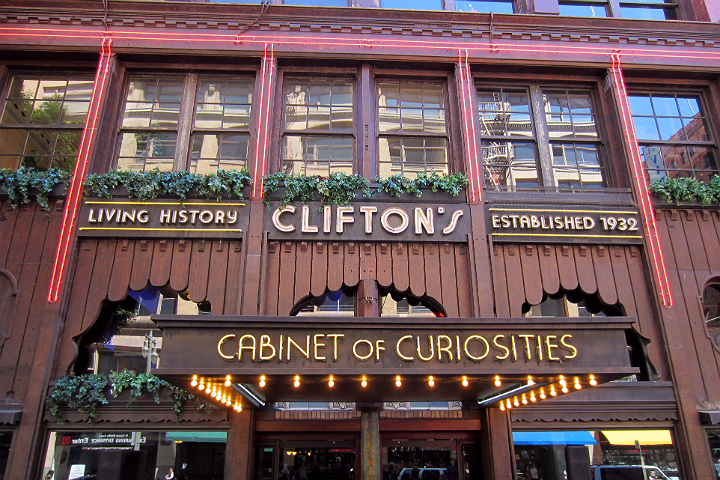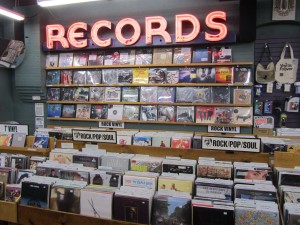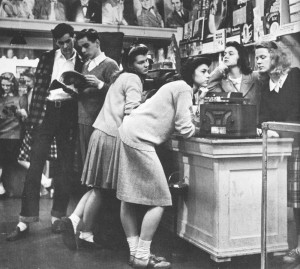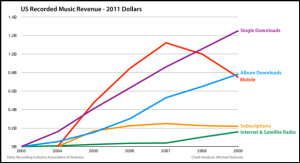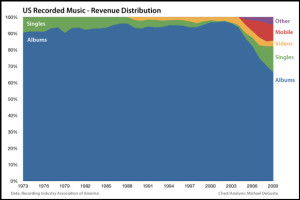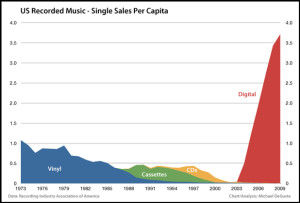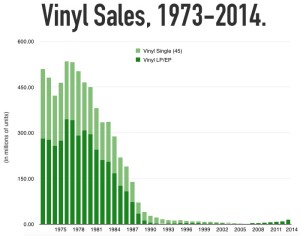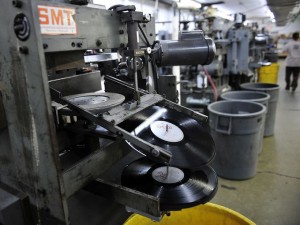Tucked away in the quiet Arts District of downtown Los Angeles (DTLA) stands the aged brick alleyway of Daily Dose Café, which once served as the primary railroad passage to deliver goods in the city; however, it now operates as a local gathering place for the growing community of entrepreneurs, artists and young professionals settling in the area. Photographers cluster at the entrance of the pathway setting up their camera equipment and preparing for a photo shoot while a group of twenty-something year olds chat and sip their iced coffees at a nearby table. The image of downtown Los Angeles has radically changed within the last few decades. The Daily Dose Café and Arts District are prime examples of the transforming social and physical landscapes that DTLA has undergone in recent years.
Timeworn structures ranging from the historic theatres on Broadway to the old, abandoned warehouses and factories that are scattered throughout the downtown area, especially in the Arts District, are being revitalized and transformed into lofts, hybrid industrial (HI) living and work spaces, restaurants, and bars to appease its latest residents. The redevelopment projects and revitalization efforts to repurpose these existing structures and urban neighborhoods would be considered one of the primordial stages of a process known as gentrification.
What is Gentrification?
The process of gentrification begins when investors and development companies start infiltrating an existing city in an effort to renew and restructure abating areas to accommodate the influx of middle-class and affluent citizens moving into the city. Subsequently, the gentrification process displaces the city’s original, lower-income residents and business owners that are incapable of paying the higher cost of rent to live and operate a business in the city. The debate as to whether or not gentrification is a progressive or adverse development for a city remains at question.
A Change for the Better?
Certainly there are both positive and negative sentiments that could be shared regarding the issue of gentrification depending on whom you ask. Dana Cuff, a professor of architecture and urban design at the University of California at Los Angeles (UCLA), has highlighted a few of the issues that arise when gentrification occurs.
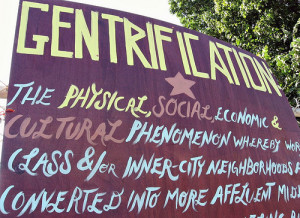 The first problem that would occur would be change in housing affordability, whereas the second would be compromising the overall character of an existing neighborhood as a consequence of the method.
The first problem that would occur would be change in housing affordability, whereas the second would be compromising the overall character of an existing neighborhood as a consequence of the method.
Gentrification challenges the concept of social justice within a city amongst its residents. The process leaves the lower-income residents in the city with no other option than to relocate, as they are now unable to afford the higher living costs of the area. As a result, this in turn causes individuals and families to either become homeless or are forced to transfer to higher crime rate neighborhoods that may leave them more susceptible to gang and street violence.
Additionally, by relocating a city’s indigenous residents, neighborhoods lose the rich cultural identity that it once possessed. Because the culture of the prior neighborhood is not preserved an area that may have once been known as being predominately Hispanic, for example, would lose that unique characteristic value.
On the other hand, a few positive features that are often upheld regarding the justification of gentrification are that it can boost a city’s economic standing as well as establish a platform for the city to ultimately flourish. Gentrification generates jobs and property-tax revenue for a city. Designing and opening dog parks and new coffee shops would purportedly prompt further development in the city, which would increase property-values. City officials and public figures are particularly attracted to the concept of gentrification because it can guarantee monetary advances for a city.
Loretta Lee, a professor of Human Geography at King’s College, disclosed that the financial gains that gentrification presents for a city are great. Lee stated that gentrification aids in a city’s overall effort to garner tourist dollars, new residents and attract more investors in the universal scale of capitalism and competition amongst cities.
Another celebrated effect of gentrification is that it reduces crime rates within cities because greater numbers of law enforcement officers are usually recruited to generate a sense of safety for its newest residents. Typically, along with the gentrification process comes the demand for improved policing.
Los Angeles Police Chief Charlie Beck has stated that implementing community policing, in which law enforcement officers patrol a neighborhood on foot and become personally involved with the community members and develop a safer community by establishing a better relationship with the community, has operated as a significant contributor to the waning crime rates that Los Angeles has been experiencing for the past decade (Aguilar, “LAPD: Crime in Los Angeles).
Moreover, Los Angeles Mayor, Eric Garcetti, has revealed that crime rates declined for the 11th consecutive year as 2013 came to a close. According to Garcetti’s office, Part 1 crimes, which would include homicide, rape and burglary, were down 5.2 percent (“LAPD Highlights Drop”).
Who is Moving Downtown?
There have been numerous articles published in recent years that have pondered and investigated the latest desire that many young Americans possess to move to the golden coast. The New York Times recently published an article stating that many east coast natives are choosing to relocate to Los Angeles for the opportunities that are arising in the business, technology and creative industries.
 Examining the demographics provided by the 2013 Downtown of Los Angeles Demographic study, which was published by the Downtown Center BID and the United States Census Bureau’s demographics for Los Angeles County, has revealed that there are approximately 52,400 individuals that reside in downtown, which is nearly double when compared to its 2000 numbers that documented a total of 27,849 residents; and roughly 64 percent of current inhabitants in Downtown Los Angeles rent property.
Examining the demographics provided by the 2013 Downtown of Los Angeles Demographic study, which was published by the Downtown Center BID and the United States Census Bureau’s demographics for Los Angeles County, has revealed that there are approximately 52,400 individuals that reside in downtown, which is nearly double when compared to its 2000 numbers that documented a total of 27,849 residents; and roughly 64 percent of current inhabitants in Downtown Los Angeles rent property.
Of these residents, the average annual household income figure is $98,700. The 2013 average household income figure has increased tremendously when compared to the city’s 2007 average annual household income amount, which was around $54,000 (“Big Numbers and Big Money in Downtown Survey”). Furthermore, the current average rental price for a loft, apartment, or condo is $1,900.
The influx of new residents wanting to settle in Los Angeles can be perceived positively as it will enhance the city’s economic standing, but it begs the question as to where the new occupants will reside.
A Rising Housing Market
Downtown’s rising popularity and its low availability have enabled developers to raise their asking prices for living spaces, and it is growing increasingly common for rental prices to be more than $4 a square foot. Even at $4 a square foot that is about a 50% increase than what prices were a decade ago.
These statistics would indicate that neighborhoods in downtown have become primarily composed of middle and upper class individuals and families. Higher housing costs would clearly create a large disparity between the type of individuals that would be residing downtown, and it would force those whom do not make enough income to move out of the area.
An anecdote that seamlessly illustrates this concept would be that of Vanny Arias. Vanny Arias, whom is a single mother of three residing in a neighborhood a few miles east of Downtown Los Angeles, has revealed that the consequences of gentrification are evident within her community. Arias had to move out of her former home off of Avenue 52 and York Boulevard when rent became unaffordable, and she now resides in a single bedroom apartment with her children. “I can’t help but feel angry. How are they going to raise our rent like that? Everything I know is here.” Arias shared (Solis, “Highland Park Residents”).
As what is demonstrated in Arias’ story, gentrification places one faction of individuals at odds. The California Supreme court attempted to ease the affordable housing crisis that the state is currently facing by passing a housing ordinance that would require developers building 20 or more units to list 15 percent of them below-market price or to pay into a city fund for low-cost housing. But even with the Supreme Courts efforts, housing affordability remains a huge concern for Angelenos as most are unable to keep up with the speed at which housing prices are rising.
For Those Who Can Afford to Stay, Where to Settle?
The city’s redevelopment efforts have extended beyond the constraints of the central downtown area. Redevelopment project are occurring throughout the entire perimeters of Los Angeles County. Gentrification can be observed to the north of downtown around Echo Park and Silverlake, to the east around the Boyle Heights area and to the south and west near USC and Koreatown.
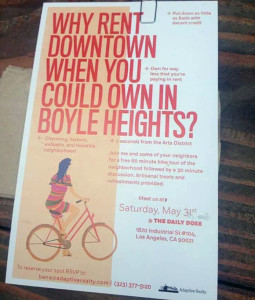 To address these concerns, there have been public hearings held at the Los Angeles City Hall recently regarding the proposal of investors and developers to begin improvement projects to the area Northeast of downtown in hopes of transforming nonoperational factories and warehouses into hybrid industrial living and work spaces.
To address these concerns, there have been public hearings held at the Los Angeles City Hall recently regarding the proposal of investors and developers to begin improvement projects to the area Northeast of downtown in hopes of transforming nonoperational factories and warehouses into hybrid industrial living and work spaces.
The proposed Hybrid Industrial Live-Work Zone Ordinance states that the city has a dire need for these transformations.
The ordinance states, “It called for new zones that address the full range of industrial areas found in the City, including industrial mixed use districts—areas that retain a jobs focus but which may support limited residential uses… The proposed zone is a new zoning tool that would permit new construction of live/work, mixed use projects in appropriate industrial areas as a means to implement City policies related to economic development, job retention, and housing production” (“HYBRID INDUSTRIAL LIVE/WORK”).
Jesse Martin, the founder and owner of Value Produce, which is located off Central Avenue in Downtown Los Angeles, has witnessed the transformation of downtown since opening his business in 1992. Value Produce is a family owned and operated produce company that supplies Southern California markets with produce from around the world, including: Chile, Peru, Brazil, and Ecuador amongst others. The location of Value Produce cradles the border of the Arts District and the Fashion District in downtown Los Angeles. Both of which locations are appealing areas that investors and developers have already begun renovating.
When questioned about his sentiments regarding gentrification, Martin said that he perceives the process positively. He stated how he could recall the way the city was prior to the changes. “It [Gentrification] allows cities to grow and businesses to grow to help make the economy stronger,” said Martin.
Currently, Martin has over 50 active employees. None of which live downtown, but rather in cities 20 minutes away. Martin shared that he supports the Hybrid Industrial Live-Work Zone Ordinance, as he would like to see more of his employees have an easier commute to work.
“These guys work hard and the commute to and from work could easily take over an hour with traffic. After a hard day’s work – which includes labor intensive tasks like lifting palettes – a long drive is the last thing my guys want to do,” said Martin.
Whether you encourage gentrification or oppose it, the redevelopment process is a part of our country’s past, present and will undoubtedly continue to be present in its future. Aside from Los Angeles, traces of gentrification can be identified in any major city within the United States.
While some entities, such as civic leaders and political actors, encourage redevelopment efforts and gentrification as a measure to improve a city’s value, there remains a faction of others, such as low-income renters, whom oppose the process.
Therefore, as citizens, we must become aware and knowledgeable about issues that will impact us directly, such as gentrification. We must ask questions and truly evaluate at what cost we are paying for this change and to determine if it is really worth it both socially and economically?
SOURCES
http://www.vice.com/read/gentrification-comes-to-las-skid-row-and-the-homeless-get-the-shaft
https://www.highbeam.com/doc/1P3-3718902691.html
http://planning.lacity.org/Documents/policy/HIZoneFAQandOrdinance.pdf
Lomeli, M. (2014). White nostalgic redevelopment: Race, class, and gentrification in downtown los angeles (Order No. 3645664). Available from ProQuest Dissertations & Theses Full Text; ProQuest Dissertations & Theses Global. (1626384695).
http://www.laweekly.com/news/is-gentrification-ruining-los-angeles-or-saving-it-pick-a-side-5342416
http://www.economist.com/news/united-states/21644164-gentrification-good-poor-bring-hipsters

